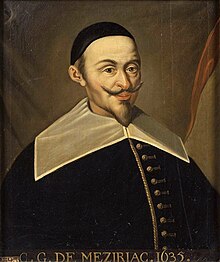| Claude Gaspar Bachet de Méziriac | |
|---|---|
 | |
| Born | (1581-10-09)9 October 1581 Bourg-en-Bresse, Duchy of Savoy |
| Died | 26 February 1638(1638-02-26) (aged 56) Bourg-en-Bresse, Duchy of Savoy |
| Occupation | Mathematician |
| Notable work |
|
Claude Gaspar Bachet Sieur de Méziriac (9 October 1581 – 26 February 1638) was a French mathematician and poet born in Bourg-en-Bresse, at that time belonging to Duchy of Savoy. He wrote Problèmes plaisans et délectables qui se font par les nombres, Les éléments arithmétiques, and a Latin translation of the Arithmetica of Diophantus (the very translation where Fermat wrote a margin note about Fermat's Last Theorem). He also discovered means of solving indeterminate equations using continued fractions, a method of constructing magic squares, and a proof of Bézout's identity.
Biography

Claude Gaspar Bachet de Méziriac was born in Bourg-en-Bresse on 9 October 1581. By the time he reached the age of six, both his mother (Marie de Chavanes) and his father (Jean Bachet) had died. He was then looked after by the Jesuit Order. For a year in 1601, Bachet was a member of the Jesuit Order (he left due to an illness).
Bachet lived a comfortable life in Bourg-en-Bresse. He married Philiberte de Chabeu in 1620 and had seven children.
Bachet was a pupil of the Jesuit mathematician Jacques de Billy at the Jesuit College in Rheims. They became close friends.
Bachet wrote the Problèmes plaisans et délectables qui se font par les nombres of which the first edition was issued in 1612, a second and enlarged edition was brought out in 1624; this contains an interesting collection of arithmetical tricks and questions, many of which are quoted in W. W. Rouse Ball's Mathematical Recreations and Essays.
He also wrote Les éléments arithmétiques, which exists in manuscript; and a translation, from Greek to Latin, of the Arithmetica of Diophantus (1621). It was this very translation in which Fermat wrote his famous margin note claiming that he had a proof of Fermat's Last Theorem. The same text renders Diophantus' term παρισὀτης as adaequalitat, which became Fermat's technique of adequality, a pioneering method of infinitesimal calculus.
Bachet was the earliest writer who discussed the solution of indeterminate equations by means of continued fractions. He also did work in number theory and found a method of constructing magic squares. In the second edition of his Problèmes plaisants (1624) he gives a proof of Bézout's identity (as proposition XVIII) 142 years before it got published by Bézout.
He was elected member of the Académie française in 1635.
Notes
- ^ French for 'Pleasant and delectable problems that are done by numbers'
- ^ French for 'Arithmetical elements'
References
- ^ Wolfgang K. Seiler: Zahlentheorie . Lecture notes, University of Mannheim, 2018 (German, retrieved 9 April 2021)
- ^ O'Connor, John J.; Robertson, Edmund F., "Claude Gaspar Bachet de Méziriac", MacTutor History of Mathematics Archive, University of St Andrews (retrieved 9 April 2021; "Claude Gaspar Bachet (1581–1638) – Biography – MacTutor History of Mathematics". Archived from the original on 3 July 2020. Retrieved 25 November 2021.
{{cite web}}: CS1 maint: bot: original URL status unknown (link)) - Richard A. Mollin: Fundamental Number Theory with Applications. CRC Press, 2008, ISBN 9781420066616, p. 279
- ^ W. W. Rouse Ball: A Short Account of the History of Mathematics (4th Edition, 1908) as quoted at
- Simon Singh: Fermat's Enigma: The Epic Quest to Solve the World's Greatest Mathematical Problem. Walker, New York, 1997, ISBN 0-8027-1331-9, pp. 56–57, 61–63
- Claude Gaspard Bachet, sieur de Méziriac, Problèmes plaisants et délectables… , 2nd ed. (Lyons, France: Pierre Rigaud & Associates, 1624), pp. 18–33. On these pages, Bachet proves (without equations) "Proposition XVIII. Deux nombres premiers entre eux estant donnez, treuver le moindre multiple de chascun d'iceux, surpassant de l'unité un multiple de l'autre." (Given two numbers relatively prime, find the lowest multiple of each of them one multiple exceeds the other by unity (1).) This problem (namely, ax – by = 1) is a special case of Bézout's equation and was used by Bachet to solve the problems appearing on pages 199 ff.
Further reading
- Schaaf, William (1970). "Bachet de Méziriac, Claude-Gaspar". Dictionary of Scientific Biography. Vol. 1. New York: Charles Scribner's Sons. pp. 367–368. ISBN 0-684-10114-9.
- Ad Meskens (2010), Travelling Mathematics: The Fate of Diophantos' Arithmetic (Science Networks. Historical Studies Book 41).
External links
- Diophantus Alexandrinus, Pierre de Fermat, Claude Gaspard Bachet de Meziriac, Diophanti Alexandrini Arithmeticorum libri 6, et De numeris multangulis liber unus. Cum comm. C(laude) G(aspar) Bacheti et observationibus P(ierre) de Fermat. Acc. doctrinae analyticae inventum novum, coll. ex variis eiu. Tolosae 1670, doi:10.3931/e-rara-9423.
- Problèmes plaisans et délectables, qui se font par les nombres – digital copy at the Library of Congress
| Académie française seat 13 | |
|---|---|
|
- 1581 births
- 1638 deaths
- Writers from Bourg-en-Bresse
- 16th-century French Jesuits
- French mathematicians
- 17th-century French mathematicians
- Members of the Académie Française
- French number theorists
- Magic squares
- Greek–Latin translators
- 17th-century French translators
- 17th-century French male writers
- 17th-century French poets